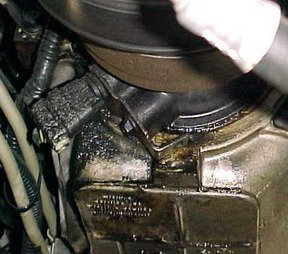
Did the warning light come on indicating an engine oil problem? Often when an engine is consuming oil, car owners might put off diagnosis for fear that large expensive auto repairs are coming their way.
This isn’t always the case, but sometimes the motorist’s worst fears are confirmed. Engine oil problems can result from both internal leaks and external ones.
An external leak may be considered by some technicians as the best case scenario. This is something you buy a new gasket for and successfully repair. On the other side of things would be the worst-case scenario.
This is when the oil consumption is caused by worn piston rings, valve guides that have excess clearances or worn valve seals. All these issues allow oil to enter the combustion chamber.
When this happens it’s burned with the air fuel mixture. The exhaust will have a notable blueish coloring, especially when first started. Internal engine problems such as worn valve guides and piston rings will require the major auto repairs that many car owners fear the most.
Sometimes in desperation automotive consumers will grab a bottle of miracle fluid hoping that an engine overhaul can be added to the crankcase in the form of a liquid. All too often they are disappointed with the results.
Diagnosing Oil Consumption

To diagnose an engine oil problem where the car seems to use too much oil, begin by checking for the best case scenario first.
If your lucky you’ll find an external oil leak. These leaks can occur at the valve cover gasket, filter and housing, as well as the front and rear main oil seals.
Pan and fuel pump gaskets on older models as well as timing covers can also leak engine oil. The timing chain cover started leaking on my 2004 Chevrolet Blazer at around 25k miles (pictured above).
When you’re searching for these external leaks remember that gravity is going to take the leaking fluid and pull it down. Drips on the oil pan should be traced to see if they are coming from valve cover gaskets or other items that could leak above.
Even a small oil leak can cause excessive consumption. There is one important point to make about an external engine leak, before the repairs are performed.
You must make sure the engine oil problem was caused by a gasket failure and not abnormal crankcase pressures or other car problems. All engines will have some type of crankcase ventilation.
In the old days these were just a breather check valve installed in the valve cover. They allowed fumes to escape. Engine blow-by is a term used to describe the gases that would naturally escape the combustion chamber and into the crankcase.
Some is considered normal. However, excessive engine blow-by is most commonly caused by worn piston rings. The engine was designed to deal with normal amounts of these fumes created by combustion by applying a vacuum to the unwanted gases sending them to the intake.
Today almost all automobiles apply a positive crankcase ventilation system. This is where they use engine vacuum cycled through a check valve to actually pull the fumes, vapors and pressures from the crankcase into the combustion chamber for burning.
If a PCV valve system fails, built-up pressure inside the crankcase can easily push out gaskets and seals. This will provide a major oil leak. This needs to be checked before replacing parts or you’ll have repeat gasket failure.
It is the PCV system that provides a continuous flow of fresh air through the crankcase to relieve the pressure and prevent the formation of corrosive contaminants as well as pressure.
Keep in mind normal crankcase pressures can also cause oil leaks in joints that are sealed by gaskets. In some cases these gaskets are defective or the retaining bolts may have backed off and loosened.
Again the important point to make about locating and repairing engine oil leaks. is to verify why it is leaking and then making sure not only the cause, but the effect is repaired properly. Otherwise it will just quickly begin to leak again.
If you’re interested in learning about testing and diagnosing engine problems this next link takes you back to more articles that cover the subject from this page about engine oil problems.
Share this page with a friend having an engine oil problem.
Some online service manuals provide diagnostic charts for oil system problems as well as technical service bulletins that might address known issues. For more information and a video visit the car repair manuals page.
If you would like to find out what else is covered on the you fix cars website this next link takes you to the homepage and also provides instructions for getting one on one auto repair advice.

